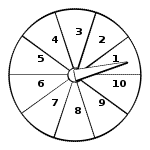Combination & Probability (1)( Week 19 Evaluation) 1. There are 14 students. If every two students will talk on phone at least once during the summer vacation, at least how many calls will they make in total? 2. Using digits 1, 2, 3, and 4, how many different 3-digit numbers can you make if no digit can be used more than once within a number? 3. Using a die(a cube with number of 1 to 6), what is the probability of throwing a 1, 2 and 4 regardless of the order? 4. A spinner shown in the diagram has 10 equal sections. The probability of the pointer falling into each section is the same (Assume the pointer will never fall on a line between two sections). What is the probability that the pointer falls on a number that is a multiple of 3?

5. Jessica accidentally saved a valuable document into a computer with 45 folders. It is equally likely that the document is in any of these folders. If exactly 6 of these 45 folders are belonging to Jessica, what is the probability that the document ended in one of her own folders? 6. I have 4 three-cent stamps and 4 five-cent stamps. Using one or more of the stamps, how many different amounts of postage can I make? 7. Richard has the following coins in his pocket: 1 penny, 3 nickels, 1 dime, and 2 quarters. 5 of these coins are taken out of the pocket and the sum of their values is recorded. How many different sums are possible? 8. There are six different three-digit numbers that can be made using the digits 4, 5, and 6. What is the sum of these six numbers? 9. What is the probability of tossing a coin twice with the outcome of 1 head up and 1 tail up regardless of the order? Express your answer as a fraction in lowest terms. 10. Smith has the following coins in his pocket: 3 pennies, 1 nickel, 3 dimes, 2 quarters, 1 half-dollar, and 3 dollars. 11 of these coins are taken out of the pocket and the sum of their values is recorded. How many different sums are possible? |